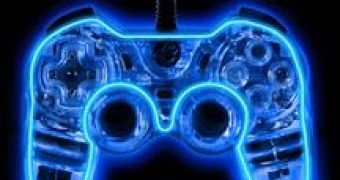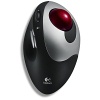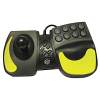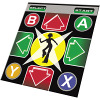I bet most of you like to play computer games. There are many computer game genres out there, which require different playing strategies and styles. For this reason, it seems that the computer keyboard and mouse configuration can prove to be quite inappropriate when it comes to efficient control. In addition, some games offer multi-player options on the same PC (take sport games like football and basketball simulations for example). In this case, keyboards tend to offer little versatility. Don't you just hate it when your keys do not respond anymore, as your opponent performs some complicated combos and presses a horde of buttons? Furthermore, things get pretty crowded with one keyboard. What you really need in this situation is a separate game controller.
Controller assault So, what's with this game controller I'm talking about? Game controllers are input devices used in order to comfortably control video games. Controllers of this kind were connected to a video games console in the early years of game development. The popularity of these devices drew the attention of computer hardware manufacturers, which quickly made them compatible with the ever evolving PCs. As soon as the early 1990s, game controllers could be found on both platforms.
Typical game controllers include the old faithful keyboard and mouse setup, gamepads, joysticks, paddles, or any other devices designed for gaming that can provide input information. Moreover, there are specially designed game controllers that simulate real-world gear, such as steering wheels for driving games and light guns for shooting games. The keyboard and mouse configuration, is already a generic input model, not necessarily limited to the functionality of a game controller.
Game controllers are mainly used to govern the movement or actions of elements in a video or computer game. The type of element controlled depends upon the game genre, but a typical element controlled would be the main character of the game. Common game controller designs may include from a couple of buttons to a dozen or more and these may be combined with multiple omnidirectional control sticks. With the aid of such designs the game elements' movement may be controlled in up to three dimensions, with many buttons to perform quick actions. The most popular game controller seems to be the gamepad, which has spread from traditional consoles, where they originated, to PCs, becoming a common input device.
The line-up There is an entire host of specific game controllers which are compatible both with game consoles and PCs.
1. Arcade controllers ? these are derived from the obsolete arcade machines, which are considered to be the parents of commercial video game consoles. Arcade controller boards have one or more joysticks that allow the user to move a character through the game, while performing actions with various additional buttons. Although appearing as a mix of gamepads and joysticks, actually this device is the predecessor of them both.
The arcade style controller proves to be a high quality gaming device for a home console or PC, being designed to replicate the arcade experience as closely as possible. In recent years, official arcade controller designs have been released with particular games. However, it is up to the gaming fans to tweak and tune arcade controllers to their needs.
2. Gamepad controllers - gamepads, also known as a joypads, are held with both hands and the thumbs are used to provide input. Gamepads generally feature a set of action buttons handled with the right thumb and a direction controller handled with the left. The direction controller has originally been a four-way digital cross (D-pad), but the latest generation of console controllers wish to standardize the analog stick as a substitute. The analog stick was introduced with the early Atari 5200 controller, but did not become too popular until the Nintendo 64, Sony PlayStation, and Sega Saturn console models. The newer console platforms use a variation of the standard gamepad design. The latest additions to the standard pad, besides the varying central buttons labeled start, select, and mode, include shoulder buttons placed along the upper edges of the pad, an internal vibrating motor to provide force feedback and one or two analog sticks.
All current console platforms come with some sort of gamepad (except the new Nintendo Wii) by default. As I have mentioned earlier, gamepads are also available for PCs, but there isn't a wide variety of computer games to support gamepads. Hardcore PC gamers are already more proficient when using custom keyboard+mouse configurations. However, there are console emulating programs for PCs which take advantage of the intuitive gamepad design. One could also encounter a breed of programmable joysticks that can be programmed to act as particular keys from the PC keyboard. The most notable device that has been designed in order to circumvent the problem lacking joystick support in some computer games is the Belkin Nostromo SpeedPad n52. Another solution is represented by the JoyToKey software, which provides keyboard input emulation for gamepads.
3. Trackballs - when we analyzed the most common types of computer mice, I'm sure ou remember that we have encountered the trackball device. This one is basically an upside-down mouse, whose ball is manipulated with the palm of one's hand. Because you don't have to move around the entire device, it has the advantage of not requiring a lot of desktop space, and, additionally, it is as fast as one can roll the ball on it. Thus, it is particularly faster than a ball mouse and may also compete with optical ones as far as sensibility is concerned. Among the games that support this device as a game controller are Centipede, Marble Madness, Golden Tee and Sonic Arcade.
4.Joysticks ? there are two kinds of widely adopted joystick designs:
? Flight Simulator Style Joystick. This type of joystick became a dedicated PC peripheral and consists of a handheld stick that pivots about the inferior end, transmitting its tilting motion in two or three dimensions to a computer. These devices are specifically designed to be used with flight simulator games. HOTAS is the most respectable company that produces this type of joysticks. It introduced extra hardware to simulate throttle and rudder controls, making for the number one provider of ?professional? flight simulation devices aimed at fanatics and hardcore gamers.
? Fighter Style Joystick ? it pretty much resembles a home version of the arcade style controller. It features a shaft that has a sphere-like graspable handle, and a variable number of buttons for in game actions. Generally the layout has the joystick on the left, and the buttons on the right. There are instances when this is reversed, or the joystick is in the center with button on both sides. They are popular with fighting and bet 'em up game genres, including Street Fighter and Mortal Kombat.
5. Steering wheels ? this is another specific controller device used for racing simulators such as Gran Turismo, Project Gotham Racing and Need for Speed. Most of them include force feedback mechanisms in order to simulate the same feedback as when driving a real car, but the realism of these features greatly depends on the game implementation. They usually come with floor pedals to control the gas and brake. The gear shifting part is handled through either a simple shifter resembling a real-life automatic gearbox, a shifter which mimics a manual gearbox, or programmable buttons resembling those on a formula one steering wheel. Most wheels turn only 200 to 270 degrees lock-to-lock, but some models, such as the Logitech Driving Force Pro, can turn 900 degrees, or 2.5 turns lock-to-lock.
6. Light gun - a peripheral used to "shoot" targets on a screen, usually resembling firearms or ray guns. Their use is normally limited to first person shooters or shooting gallery games like those that came with the "Shooting Gallery" light gun. The first home console light gun was released on the Magnavox Odyssey; later on, Nintendo would include one standard on their Famicom and NES. Nintendo also promised to release an additional controller in the style of a light gun for the new Wii console.
7. Touch screen ? a modern input device that allows the user to interact with the computer by touching the display screen. It was first used on a dedicated console produced by Tiger. Nintendo made it more popular with the introduction of the portable Nintendo DS console. Other systems that feature this technology are the Tapwave Zodiac and all the latest PDAs. Modern touch screens use a thin, durable, transparent plastic sheet overlayed onto the glass screen. The location of a touch is calculated from the capacitance for the X and Y axes, which varies based upon where the sheet is touched.
Oddities There are even more specialized game controllers that accompany a series of innovative games:* Train controls - available after Microsoft Train Simulator was released and limited to hardcore fans of the genre.
* Dance pads - essentially a grid of flat pressure sensitive gamepad buttons set on a mat meant to be stepped on, are dedicated to console games such as Dance Dance Revolution and Pump it Up. The dance pad was first introduced on the Atari 2600, called the "Exus Foot Craz" pad.
* Controllers resembling musical instruments like guitars (for the PlayStation Guitar Hero game ), drums (Nintendo's Donkey Konga), or maracas (Samba de Amigo game) are quite popular with console games.
* Buzzers ? another recent example of specialized, yet very simple game controllers, consisting of four large "buzzers" (round buttons) and supplied with the PlayStation 2 quiz show game series Buzz! (2005, 2006). Both game and controllers clearly being inspired by the television show genre.
* Wii remote ? comes with Nintendo's Wii system and resembles a TV remote control. It has motion sensors and can detect its exact location and orientation in 3D space, making it a revolutionary piece of equipment.
* Microphone ? there are few games that can successfully use a headset or microphone as a secondary controller. The use of these microphones allowes players to issue commands to the game, controlling teammates and other AI-driven characters.
* Fishing rod - appeared first as an accessory for the Sega Dreamcast video console for playing SEGA Marine Fishing. Later on, other games for the PlayStation console were realeased and Sony introduced its own fishing rod controlling device.

This concludes out short game controller presentation. Stay tuned for more computer hardware presentations.

 14 DAY TRIAL //
14 DAY TRIAL // 












